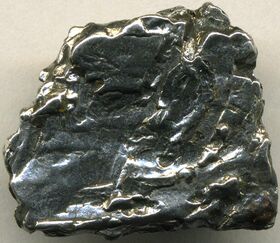Astronomy:IIICD meteorite
| IIICD meteorites | |
|---|---|
| — Group — | |
 The Nantan meteorite, an example of an IIICD meteorite | |
| Type | Achondrite |
| Class | Primitive achondrite |
| Clan | IAB-IIICD-Winonaite |
| Composition | Meteoric iron with silicate inclusions containing low-Ca pyroxene, high-Ca pyroxene, olivine, plagioclase, troilite, graphite, phosphates, meteoric iron, traces of daubréelite & chromite |
IIICD meteorites are a group of primitive achondrites. They are classified in a clan together with the IAB meteorites and the winonaites.[1]
Description
IIICD meteorites consists dominantly of meteoric iron with silicate inclusions. The silicate inclusions are almost identical to the IAB meteorite inclusions. They contain low-Ca pyroxene, high-Ca pyroxene, olivine, plagioclase, troilite, graphite, different phosphates, meteoric iron and traces of daubréelite and chromite.[1]
Parent body
It has been established that IAB meteorites and winonaites originated from the same parent body. The same is not yet clear for IIICD meteorites, that originated from the same or a very similar asteroid.[1]
Classification
The IIICD meteorites are classified as primitive achondrites because they have silicate inclusions and show signs of partial melting.[1] The silicate inclusion are almost identical to silicate inclusions in IAB meteorites, and both are very similar to winonaites. For this reason all three are grouped into the IAB-IIICD-Winonaite clan.[2]
See also
References
- ↑ Jump up to: 1.0 1.1 1.2 1.3 M. K. Weisberg; T. J. McCoy, A. N. Krot (2006). "Systematics and Evaluation of Meteorite Classification". in D. S. Lauretta. Meteorites and the early solar system II. Tucson: University of Arizona Press. pp. 19–52. ISBN 978-0816525621. http://haroldconnolly.com/EES%20716%20Fall%2009%20Reading/Lecture%201/Background%20reading/Weisberg_etal_MESSII.pdf. Retrieved 15 December 2012.
- ↑ Wasson, J.T; Kallemeyn, G.W (30 June 2002). "the IAB iron-meteorite complex: A group, five subgroups, numerous grouplets, closely related, mainly formed by crystal segregation in rapidly cooling melts". Geochimica et Cosmochimica Acta 66 (13): 2445–2473. doi:10.1016/S0016-7037(02)00848-7.
 |

